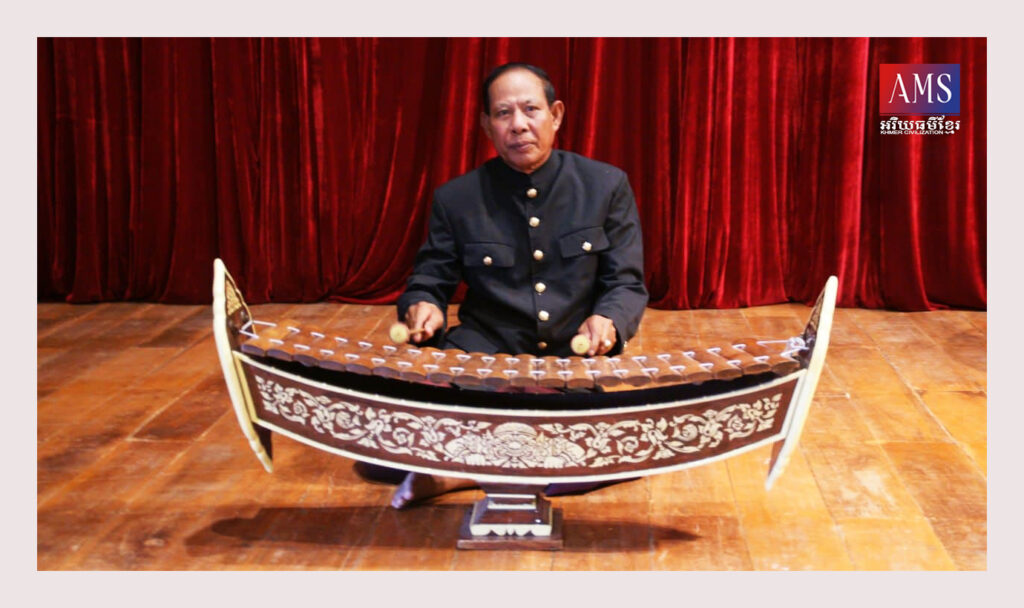«រនាត» ជាពាក្យខ្មែរ ប្រើសំដៅទៅលើក្រុមឧបករណ៍តន្ត្រីរនាតគ្រប់ប្រភេទទាំងអស់ មានរនាតឯក រនាតធុង រនាតដែក និងរនាតថោង។ រនាត ជាប្រភេទឧបករណ៍តន្ត្រីគ្រឿងដំដែលគេឃើញមាននៅក្នុងតំបន់និងប្រទេសមួយចំនួន នៅក្នុងទ្វីបអាហ្វ្រិកនិងអាស៊ី។ ដោយឡែក ប្រភេទរនាតដែលមានខ្សែចងផ្លែហើយព្យួរលើស្នូក ជាប្រភេទឧបករណ៍ តន្ត្រីដែលមាននៅក្នុងបណ្តាប្រទេសខ្លះក្នុងទ្វីបអាស៊ីតែប៉ុណ្ណោះ (ក្រៅពីអាហ្វ្រិក) ពោលគឺ ប៉ាតាឡា (pattala) របស់ភូមា រនាត (roneat) របស់ខ្មែរ និងរ៉ាណាត (ranat) របស់ថៃ។
លោក ដេវីដ ម័រតុន (David Morton) បានអះអាងថា រនាតដែលមានអាយុចាស់ជាងគេ បានត្រូវគេឆ្លាក់នៅលើប្រាសាទ បូរ៉ូប៊ូឌួរ (Borobudur) លើកោះជ្វាកណ្តាល (Central Java) នៅអំឡុងចុងសតវត្សទី៨ឬដើមសតវត្សទី៩។ លោក ម័រតុង បានបន្ថែមទៀតថា ឧបករណ៍ រ៉ាណាត របស់ថៃបានត្រូវគេគូរនៅប្រមាណអំឡុងឆ្នាំ១៧៣០ តាមបទសម្ភាសន៍ដែលខ្ញុំបានធ្វើជាមួយនឹងលោក ជា ដាវី លោកមានប្រសាសន៍ថាពាក្យ «រនាត» មកពីពាក្យ «រនាប» គឺរបស់ដែលគេរៀបដាក់ទន្ទឹមគ្នាឬបន្តជាប់គ្នា។
ការស្វែងយល់អំពីឧបករណ៍រនាតឯក
នៅក្នុងចំណោមរនាតខ្មែរទាំងអស់ រនាតឯក មានតួនាទីសំខាន់ណាស់ក្នុងការដឹកមុខឧបករណ៍តន្ត្រីឯទៀតៗនៅក្នុងវង់តន្ត្រី ដូចជាពិណពាទ្យនិងមហោរី។ ឧបករណ៍ រនាត មានចំណែកឬធាតុផ្សំបីចំណែកឬផ្នែក គឺ៖ (១) តួឬស្នូក ខោល ជើងទ្រ, (២) ផ្លែសូរ, និង (៣) អន្លូង។ ដោយឡែក រនាតឯក មាន២១ផ្លែធ្វើពីឈើឬឫស្សី ប៉ុន្តែជាក់ស្តែងនៅក្នុងការសម្តែង រនាតឯកមានតែ ១៤សូរតែប៉ុណ្ណោះ ដោយសារគេលេងជាគូ៨ផ្លែ គឺពី (F3-E5)។ ឯអ្នកចេះលេងរនាតឯកស្ទាត់ គេក៏អាច «លូក» ឬរុញផ្លែបាន។
គេជ្រើសរើសយកឈើប្រណិតលេខ១ ដែលមានសូរធ្ងន់និងពីរោះ ដូចជា ធ្នុង ក្រញូង បេង នាងនួន ឬសុពណ៌, ឬលេខ២ ដូចជា ខ្នុរ អំពឹលបារាំង ឈ្លិច ឬសង្ក្រំ។ គេរាប់ផ្លែរនាត ពីលើមកក្រោម (ផ្ទុយពីប្រព័ន្ធបស្ចឹមប្រទេស – ពីក្រោមទៅលើ) គឺផ្លែលើគេបំផុត ជាផ្លែទី១។ អន្លូងរនាត មានដងធ្វើពីឫស្សីឬឈើតាឱនឬឈើមាំ និងក្បាលធ្វើពីឈើនិងប្រមរ (ដើម្បីឱ្យធ្ងន់) ស្រោបដោយក្រណាត់និងរុំដោយអំបោះ ឱ្យឮសូរចែសឬលំ។
អ្នកលេងរនាត ត្រូវអង្គុយពីក្រោយឧបករណ៍ (រនាត) ដោយសម្រួលជើង ដៃ ដងខ្លួនឱ្យមានផាសុកភាពដើម្បីនឹងលេងរនាតបានស្រួល។ របៀបកាន់អន្លូង គឺសិស្សត្រូវធ្វើទៅតាម ការណែនាំរបស់គ្រូបង្រៀនរនាត ថាត្រូវកាន់ដងអន្លូងរនាតរបៀបណា។ របៀបកាន់នីមួយៗ ក៏មានឈ្មោះរបស់វា ដូចជា «ក្រញាំជើងគ្រុឌ» ជាដើម។ ចំពោះរនាតឯកគេលេងជាគូ៨ផ្លែ ហើយនៅពេលលេង អ្នកវាយរនាតឯកត្រូវមើលតែដៃស្តាំ ដោយដៃឆ្វេងត្រូវទៅតាមដៃស្តាំជាស្វ័យប្រវត្តិ។ គ្រូបង្រៀនរនាតឯក អាចណែនាំសិស្សរៀនរនាតថ្មីឬដំបូងឱ្យហាត់រនាតដោយចងខ្សែ ដើម្បីឱ្យសូរជាគូ៨ផ្លែនោះនៅស្ថេរ។ បច្ចេកទេសវាយអន្លូងទៅលើផ្លែរនាត គឺត្រូវប្រើកដៃ។ ឯបច្ចេកទេសរោទ៍ (Tremolo) គឺត្រូវប្រើកដៃ ឆ្លាស់ឆ្វេងស្តាំ។
របៀបរៀនរនាត គឺសិស្សត្រូវធ្វើត្រាប់តាមគ្រូ ១ឃ្លាម្តងៗ រួចហើយ១វគ្គម្តង។ សិស្សដែលចេះអក្សរភ្លេង អាចរៀនដោយប្រើអក្សរភ្លេងក៏បាន។
Khmer Xylophones
Roneat is a generic Khmer term referring to all types of xylophones. They are classified as struck idiophones or more specifically “bar idiophones.” Xylophone types of instruments are found in various parts of the world, including Africa and Asia. The types of xylophones whose keys or bars are suspended with cords over a trough resonator are indigenous only to mainland Southeast Asia. They are the Burmese Pattala, the Khmer Roneat, and the Thai Ranat.
With regard to the origin of the xylophone, Yupho suggested that the Thai created their xylophones from a pair of grap sepha. He also claimed that the Thai took several grapes and put them on a stand with the tones arranged in order from low to high. This was the origin of the xylophone type of instrument in Thailand. Morton wrote that the early xylophones were carved on temples in central Java (Borobudur) in the late eighth or early ninth century. “The first reference to a xylophone in Thailand was known to me,” said Morton, “is the illustration in the manuscript dated circa 1730.” He continued, “Whatever its early history, apparently the instrument was well established by the later part of the Ayuthya period”.
In Cambodia, the name “Roneat” comes from the word “Roneap” (bamboo strips). The Roneat has bamboo or wooden keys strung together by two cords running through holes in each key and are suspended on two hooks at the end-pieces of the resonator. Care must be taken that all the keys are well spaced so they can vibrate freely. The xylophone keys are tuned to desired pitches, using a kind of tuning blobs called Pramor (a mixture of lead, Bees wax, and Mrum rosin). In Cambodia, in the past and current practices, we find four types of xylophone, namely, Roneat Aek, Roneat Thung (Roneat Thomm), Roneat Dek, and Roneat Thaong.
According to the above documents and my personal research, I may sum up the origin and development of xylophone types of instrument, chronologically, in the following manner, but not in any way definitive, i.e., the African balafon, followed by the Indonesian Gambang, the Burmese Pattala, then, the Khmer Roneat and Thai Ranat. This leaves room for future researchers to put this issue to rest and to shed light on this important musical instrument, at least, for a time in the future.
អត្ថបទដោយ៖ បណ្ឌិត សំ សំអាង








